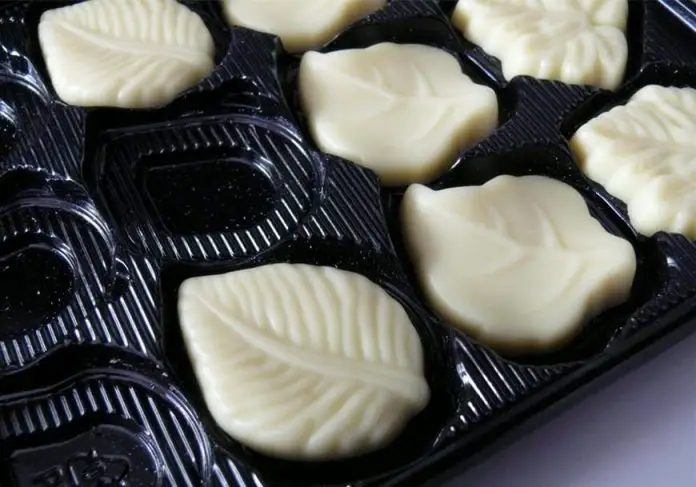You have surely heard that chocolate and dogs are a deadly combination. But is all chocolate really bad for canines? Find out if white chocolate is something you can share with your furry little friend.
What Is White Chocolate Made Of?
White chocolate is a chocolate derivative, which means the ingredient used in making it is just a by-product of the real thing. Chocolate enthusiasts even refer to it as a controversial impostor. Technically, it’s not a chocolate because it does not contain any cocoa solids.
The ingredients of white chocolate are cocoa butter, milk solids, and sugar. The only thing that somehow makes it a chocolate is the fact that cocoa butter also comes from the same beans as cocoa powder. Cocoa butter is the fat from the cocoa beans.
The Truth about Chocolates and Dogs
Canine experts have warned about this so many times: avoid giving this sweet treat to your pet or else he will become sick. The National Center for Biotechnology Information (NCBI) indicated in a report that chocolate is toxic to dogs because of its theobromine and caffeine content.
Unlike humans, dogs have a hard time metabolizing and excreting theobromine and caffeine. This is the reason why they are sensitive to the chemical effects of chocolates. The methylxanthines in chocolates cause their heart rate to race twice than normal.
Theobromine, the predominant toxin in chocolates, works as a heart stimulant and blood vessel dilator. Methylxanthines can further affect the dog if he ate the chocolates on an empty stomach. This volatile compound from cacao seeds is responsible for the chocolate’s bitter taste.
If that is the case, how come some dogs eat chocolate and nothing happens to them? Actually, it depends on three things:
- The size of the dog,
- The type of chocolate
- The amount of chocolate the dog had ingested.
Size of the dog
Smaller dogs are more prone to digestive issues than adult dogs. This is because their digestive systems are still developing. The amount of sugar and fat in white chocolate is too much for puppies to handle.
In 2017, a French bulldog puppy from South Shore, Blackpool almost died after wolfing down an entire box of chocolate liqueurs. As we all know, alcohol is also bad for dogs so it worsened the pup’s condition.
The puppy luckily survived, thanks to his owners who immediately brought him to a pet hospital. The vets flushed the chocolates from the dog’s system through induced vomiting.
A 20-pound dog would have to consume as much as 250 pounds of white chocolate to display signs of chocolate poisoning. For dogs weighing 10 lbs. and below, it will take 110 pounds of white chocolate for them to be in danger.
That only means you should not panic if your pooch accidentally gobbled down a small bar of white chocolate. Just imagine how much chocolate 200 lbs. really is! It is more than a hundred pieces of jumbo chocolate bars.
Type of chocolate
Baking chocolate and cocoa powder contain the highest concentration of theobromine. Gourmet dark chocolates also have high amounts of it. Below are the types of chocolate products with the highest theobromine content, according to My Food Data. The amounts given are for every cup.
- Dry cocoa powder – 2634 mg
- Unsweetened baking chocolate – 1297 mg
- Dark chocolate with 70-85% cacao solids – 802 mg
- Dark chocolate with 60-69% cacao solids – 632 mg
- Dark chocolate with 45-59% cacao solids – 493 mg
- Semisweet chocolate chips – 486 mg
- Sweet chocolate candies – 426 mg
- Dark chocolate-coated coffee beans – 368 mg
- Chocolate cookies – 354 mg
- Cocoa mix powder – 323 mg
White chocolate is not on the list because it contains an insignificant amount of theobromine. An ounce of milk chocolate only has 60 mg of theobromine. It also does not have caffeine. The fats derived from the cocoa beans only contain a small trace of caffeine that is so low it is already considered caffeine-free.
Amount of white chocolate
The NCBI emphasized that it will take extremely large amounts of white chocolate for dogs to get sick. According to chocolate toxicity calculators, no symptoms are expected if a 30-pound dog ate an ounce of white chocolate.
Still, you have to continue monitoring your dog closely. If the dog experienced seizures, tremors, hyperactivity, irregular heart rate, call the pet poison helpline.
Risks of Giving White Chocolate to Dogs
We are now in the juicier part of today’s post. If white chocolate isn’t toxic to dogs, does that mean you can give it as a treat? Yes, but still practice caution in giving it to your dog.
The real concern with white chocolates is their high levels of fat and sugar. Aside from milk solids, they also contain milk fats. Some manufacturers add vanilla to give it the chocolate extra flavor as well as the lecithin emulsifier.
The problem with dogs is that most of them are lactose intolerant. White chocolate does not only contain milk solids but also milk fat that could upset your dog’s stomach. It’s highly likely for a dog to experience diarrhea if he consumed a lot of white chocolate.
If your dog can tolerate goat’s milk, since it does not contain a lot of lactose, better opt for white chocolates made with this type of dairy. There are brands out there that use goat’s milk for their dairy component.
It’s also important to look at the other possible ingredients of the chocolate. Pistachios, for instance, are now being added to white chocolate to give it a nutty taste. Avoid giving white chocolates with pistachios to dogs. These nuts are not really toxic for them but they are quite high in fat.
Never give white chocolate-covered raisins to dogs. Raisins or dried grapes can be fatally toxic to dogs, regardless of their age, size, or breed. They could develop acute kidney conditions from consuming raisins or grapes.
According to the Food and Drug Administration guidelines, for a candy to be qualified white chocolate, it should have the following percentage:
- At least 20% cocoa butter
- 14% milk solids
- 5% milk fat
- No more than 55% sugar/ other sweeteners
Let’s talk about those other sweeteners. The term is quite vague because there are a plethora of sweeteners out there other than table sugar. And we all know not all of them are safe for dogs. Xylitol, for instance, is a big no-no for doggies. In fact, it is more toxic to dogs than chocolate.
There are existing white chocolates made with xylitol. This crystalline alcohol is often used as an ingredient in sugar-free chocolate bars. Check the label before giving white chocolate to dogs and make sure it does not have xylitol.
Some brands of white chocolate contain a whopping amount of cocoa butter. Since the FDA only required at least 20%, that means manufacturers could use 30% or even higher. These types of white chocolate are suitable for baking and should not be given to dogs.
Dog-friendly White Chocolate Recipes
Making white chocolate at home is a breeze. If you haven’t tried making your own chocolate before, maybe now is the right time. It’s actually exciting! Plus, you will not feel so guilty about eating these white chocolates yourself because they are healthy.
Sugar-free White Chocolate
This white chocolate does not contain sugar and it does not use xylitol. The sweetener used for this recipe is stevia, which is definitely safe for dogs. Stevia is a sugar substitute derived from plants and it has no calories. This natural sugar alternative is even helpful for people with glucose intolerance.
- In a large bowl, mix the 1/3 cup of melted and slightly cooled coconut oil and 2 ounces cocoa butter.
- Add in 1/3 cup of dry milk powder. You may also use coconut milk powder. Mix well.
- Whisk in 3 tablespoons of granulated stevia.
- Add a pinch of fine sea salt.
- Pour the mixture into molds.
- Chill in the refrigerator.
Vegan White Chocolate
All the ingredients used in this recipe are completely organic, right from the cacao butter down to vanilla powder. Like our first white chocolate recipe, the sweetener used for this one is also safe for canines. Maple syrup is derived from the sap of sugar maple, red maple, or black maple.
- Melt around 150 grams of organic cacao butter in a double broiler.
- Pour in 3 tablespoons of organic maple syrup.
- Whisk frequently until the maple syrup and the cacao butter are well-combined.
- Allow to cool for 15 minutes.
- Once the mixture is slightly warm, add in 150 grams of melted organic coconut butter.
- Add around ¼ tablespoon of organic vanilla powder. If using vanilla bean, you may use half of it.
- Add a pinch of fine Himalayan salt.
- Keep mixing until all the ingredients are nicely combined.
- Pour the mixture into a tin lined with baking paper.
- Place in the chiller until it is completely set.
Honey-Sweetened White Chocolate
Dogs can benefit from the many health attributes of honey. It is a great source of antioxidants, it supports heart health, and it boosts energy. It is also an effective natural remedy for kennel cough and skin allergies. When buying honey, look for local raw products.
- In a saucepan, melt 3 ounces of cocoa butter over medium heat.
- Add in 3 tablespoons of honey, a teaspoon of powdered milk, and seeds from one vanilla bean.
- Keep stirring until you get a smooth consistency.
- Adjust the heat temperature to 120°F as you continue whisking. This prevents the chocolate from having a grainy texture.
- Turn off the heat. Allow to cool for 5 minutes but continue stirring.
- Once it has cooled, refrigerate for 5 minutes.
- Take it from the fridge and return it to the stove at 87°F melting temperature.
Just a safety reminder, white chocolate should only be given as a treat. No matter how healthy the white chocolate is, it should not be given as a regular snack to dogs. Besides that, don’t forget to brush Fido’s teeth after giving him a sweet treat like white chocolate.
Conclusion
White chocolate is not toxic to dogs because it contains an insignificant amount of theobromine and caffeine. However, it may have high amounts of sugar and fats that are not good for dogs just like they are not good for humans. If you want to share white chocolate with your pet, only do it once in a while and in reasonable amounts. You can also use it as a dip for your pet’s biscuits.





















